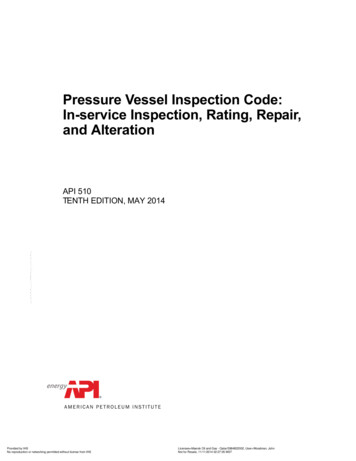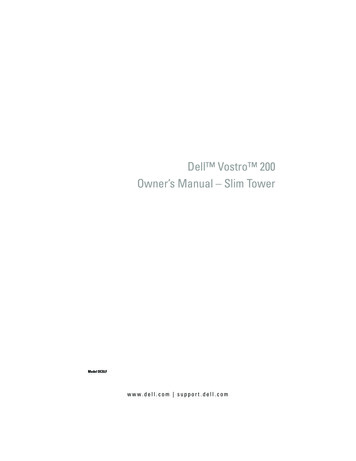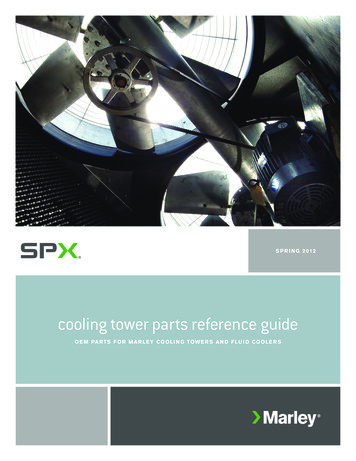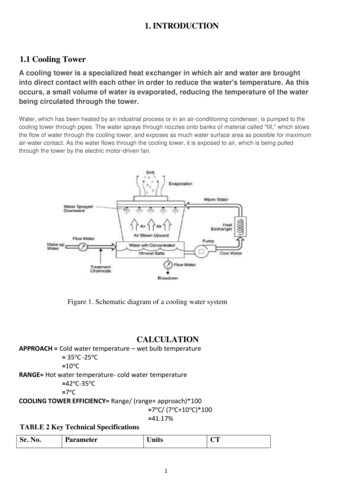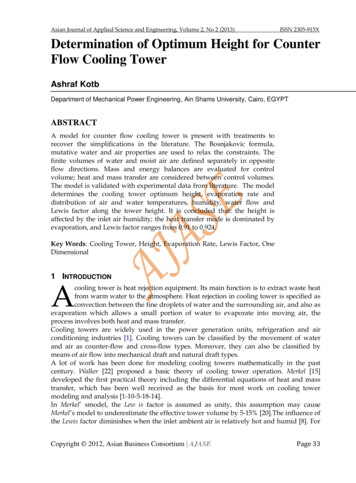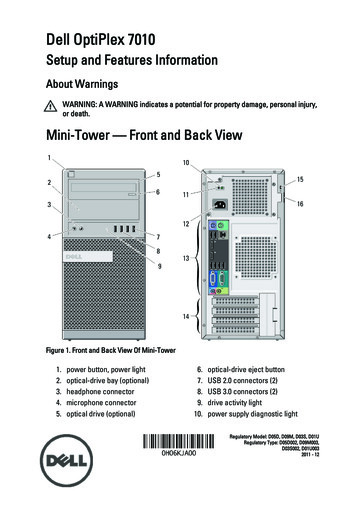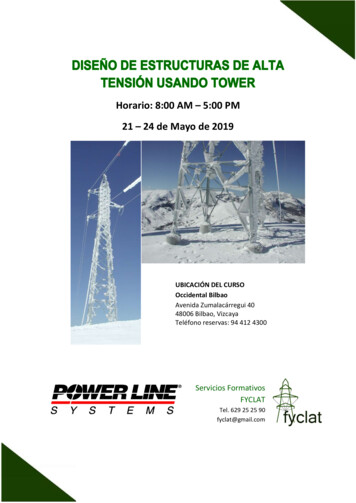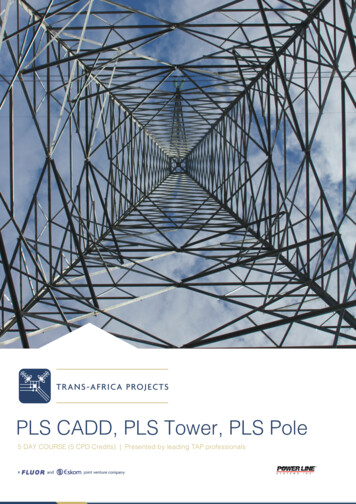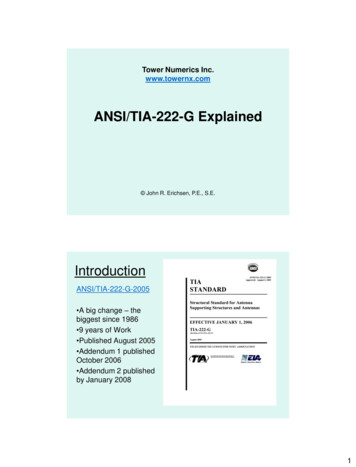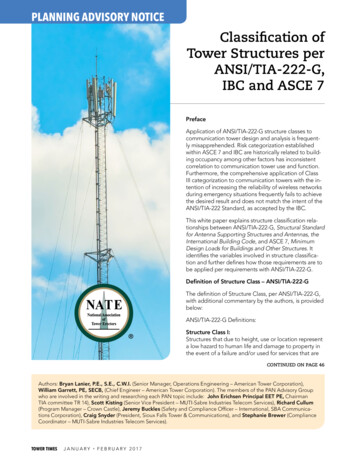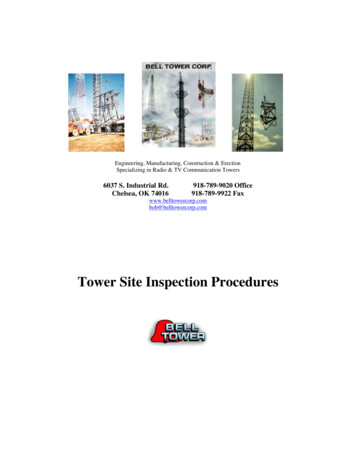
Transcription
Engineering, Manufacturing, Construction & ErectionSpecializing in Radio & TV Communication Towers6037 S. Industrial Rd.Chelsea, OK 74016918-789-9020 Office918-789-9922 Faxwww.belltowercorp.combob@belltowercorp.comTower Site Inspection Procedures
Engineering, Manufacturing , Inspections& Installations6037 S. Industrial RDChelsea, OK 74016918-789-9020Owners of towers should perform initial and periodic tower inspections and maintenance toassure safety and to extend the service life. It is recommended that major inspections beperformed when:A.) After every severe wind and/or ice storm or any other extreme conditions.B.) One-year maximum interval for Class III structures. Refer to Table 2-1 of TIA/EIA RS222-G for a definition of each class. Most guyed broadcast towers will be Class III.C.) At the completion of any major installation/maintenance performed on the tower. Havethe work inspected to insure the installation was performed in accordance with thedesign. Also, damage to tower members can occur from the rigging required forinstallation. The tow most common damages are bent members due to improper riggingconnections to the tower and burning grooves in tower members due to the load linebeing to close to the tower face.D.) Use the maintenance and condition assessment guidelines from Annex J of TIA/EIA RS222-G.E.) Include an inventory of existing equipment with the inspection.Some of the items listed below apply to new and existing tower infrastructures.I.Tower Conditions (guyed and self-supporting)A. Members1. Bent members (legs and lacing)2. Loose members3. Missing members4. Climbing facilities, platforms, catwalks-all secure5. Loose and/or missing boltsB. Finish1.2.3.4.C. Lighting1.2.3.4.Paint and/or galvanizing conditionRust and/or corrosion conditionsFAA or ICAO color marking conditionsWater collection in members (to be remedied, e.g., unplug drain holes,etc)Conduit, junction boxes and fasteners weather tight and secureDrains and vents openWiring conditionControllers functioninga. Flashersb. Photo controlc. Alarms5. Light lenses6. Bulb condition (Option: change all bulbs at one time)
Engineering, Manufacturing, Inspections & Installations6037 S. Industrial RDChelsea, OK 74016918-789-9020D. Grounding1. Connections checked and secure2. Corrosion observed and remedied3. Lightning protection secure (as required)E. Tower Base Foundation1. Ground Conditionsa. Settlements or movementsb. Erosionc. Site condition (standing water, drainage, trees, etc)2. Base Conditiona. Nuts and lock nuts tightb. Grout conditionGuy wires must be kept clean and clearof dirt and debris.3. Concrete Conditiona. Crackling, spalling or splittingb. Chipped or broken concretec. Honeycombingd. Low spots to collect moistureF. Tower Base Foundation1. Ground Conditionsa. Settlements or movementsb. Erosionc. Site condition (standing water, drainage, trees, etc)2. Base Conditiona. Nuts and lock nuts tightb. Grout condition3. Concrete Conditiona. Crackling, spalling or splittingb. Chipped or broken concretec. Honeycombingd. Low spots to collect moistureII.Guyed TowersA. Anchors1. Settlement, movement or earth cracks2. Backfill heaped over concrete for water shedding3. Anchor rod condition below earth (12” minimum)4. Corrosion5. Grounding6. Anchor head clear of earthB. Tower Guys1. Stranda. Type (1x7 EHS, 1x19 bridge strand, etc)b. Sizec. Breaking Strength
Engineering, Manufacturing, Inspections & Installations6037 S. Industrial RDChelsea, OK 74016918-789-9020d. Elevatione. Condition (corrosion, breaks, nicks, kinks, etc)AM tower’s base insulator is a crucialpart of the structure and must bechecked for cracks and other structuralwear.2. Guy Hardwarea. Turnbuckles (or equivalent) secure and safety properly appliedb. Cable Thimbles properly in place (if required)c. Service sleeves properly in place (if required)d. Cable connectors (end fittings)1. Cable clamps applied properly and bolts tight2. Preformed wraps properly applied, fully wrapped andsleeve in place3. Wire serving properly applied4. Strandvices secure5. Poured sockets secure and showing no signs ofseparation. (Note: Connectors should show no sign ofdamaged cable or slippage)e. Shackles, bolts, pins and cotter pins secure and in good condition3. Guy Tensionsa. Tension should be checked by manufacturer’s recommendationsNotes:1.) Variations in guy tensions are to be expected due to temperature and wind. These are minorvariations. Should there be significant tension changes, the cause should be determinedimmediately and proper remedial action taken. Possible causes may be initial constructionloosening, extreme wind or ice, anchor movements, base settlement or connection slippage.2.) Tension variations at a single level are to be expected because of anchor elevationdifferences, construction deviations, and wind effects.Caution: Do not check or adjust guy tensions during times of excessive winds.III.Antennas and FeedlinesA. Antenna Mounts and Antennas1. Membersa. Bent, broken or crackedb. Loosec. Missingd. Loose and/or missing bolts2. Adjustments secure and locked3. Elementsa. Bent, broken, cracked or bullet damagedb. Loosec. Missingd. Loose or missing fasteners4. Corrosion condition5. Radomes or cover conditions
6037 S. Industrial RDChelsea, OK 74016918-789-9020Engineering, Manufacturing, Inspections & InstallationsB. Feed lines (waveguide, coax, etc)1. Hangers and supportsa. Conditionb. Qualityc. Corrosion conditionSpecified by the FCC, proper signs should beposted on the tower or near it, aside from thosein plain view by the public at the gate of thepremises.2. Flanges and seals (check integrity)3. Line Conditiona. Dentsb. Abrasionsc. Holesd. Leakse. Jacket condition4. Groundsa. Top ground strap bonded both endsb. Bottom ground strap bonded both ends5. Feedline support (ice shields)a. Properly attachedb. Loose and missing boltsc. Members straight and undamagedPhysical changes in the antenna systemcan affect a directional array, but it isequally important to inspect tower fencesand clear ground vegetationIt is important to check the towerbase insulator, spark gaps andtower feedline regularly.Guy anchor showing the turnbucklesafety in figure-eight formation asrequired by TIA/EIA 222.Stainless steel cotter pins are best. Thisanchor plate is cold galvanized for protectionfrom rust.
D.) Use the maintenance and condition assessment guidelines from Annex J of TIA/EIA RS 222-G. E.) Include an inventory of existing equipment with the inspection. Some of the items listed below apply to new and existing tower infrastructures. I. Tower Conditions (guyed and self-supporting) A. Members 1. Bent members (legs and lacing) 2. Loose .
